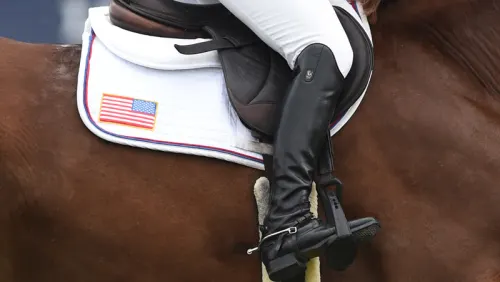An international court has overturned on appeal the Fédération Equestre Internationale Tribunal’s 20-year suspension of endurance athlete Sheik Abdul Aziz Bin Faisal Al Qasimi of the United Arab Emirates. The Court of Arbitration for Sport eliminated all sanctions, ruling the FEI had not met the burden of proof to hold him responsible for either abuse or illegal administration of a prohibited substance.
The initial FEI Tribunal ruling involved the horse Castlebar Contraband, ridden by Sheik Abdul Aziz Bin Faisal Al Qasimi at the CE1* in Fontainebleau (France) on Oct. 15, 2016. The horse suffered an open fracture to its front right cannon bone during the event and had to be euthanized.
Blood samples collected from the horse post mortem revealed the presence of the xylazine, which is used as a sedative, analgesic and muscle relaxant but is prohibited in FEI competition.
The 20-year FEI suspension, the longest punishment yet handed out by the organization, combined two years for presence of the prohibited medication and 18 years for alleged abuse of the horse.
“The post mortem report revealed the appearance of multiple lesions with a highly targeted location, consistent with recent injections, which the FEI stated demonstrated that the horse had been nerve blocked (desensitized) in training, and both before and during the competition,” the FEI stated in a press release about the CAS decision. “The FEI’s view was that this desensitization, in combination with osteoarthritis in the right front fetlock joint, resulted in stress fractures that ultimately caused the catastrophic injury.”
In making its initial ruling, the FEI Tribunal accepted the explanation of the treating veterinarian who performed the euthanasia that she had followed the standard protocol, which did not include the use of xylazine, refuting the claim by Sheik Abdul’s legal team that xylazine had been used in the euthanasia process.
ADVERTISEMENT
The CAS, however, ruled that the balance of evidence—namely, the concentration of xylazine and the lack of the sedatives the treating veterinarian said she administered found in the horse’s post-mortem blood sample—favored Sheik Abdul’s argument that it had been administered within an hour of the horse’s euthanasia, most likely, mistakenly, by the veterinarian instead of the other sedatives.
The CAS panel also noted “strong disagreement” between witnesses brought forth by the FEI and Sheik Abdul as to whether the horse was showing signs of pain or attempting to put weight on the broken leg while waiting for veterinary attention.
In considering the allegations of horse abuse, chief among them that the horse had been desensitized to the point it competed on a compromised leg that ultimately fractured, CAS noted “the more serious the allegation and its consequences, the higher certainty (level of proof) the Panel would require to be ‘comfortabl[y] satisfied.’ ”
In its decision, the CAS panel determined that neither the athlete nor his veterinarian could have “reasonably detected” alleged bone fatigue in the horse.
The CAS panel found that, because the horse had passed the horse inspection the day before the event and had also passed the veterinary checks at the vet gates during the competition, it could not be ruled as being unfit to compete. The panel ruled that the FEI had failed to establish that the athlete competed on an exhausted, lame or injufred horse or committed “an action or omission which caused or was likely to cause pain or unnecessary discomfort to a horse.”
As a result, the CAS panel found that Sheik Abdul had not committed a violation of Article 142.1 of the FEI General Regulations and that, therefore, no sanctions for abuse of horse could be imposed. The panel ruled all findings and sanctions imposed by the FEI Tribunal to be “ill founded” and ordered that they be set aside.
ADVERTISEMENT
“While it is true that circumstantial evidence may have some probative value, the fact remains that, in a case such as the present, which concerns severe allegations of abuse of horse that may, if established, entail heavy sanctions for the Appellant, there must be cogent evidence establishing the commission of the alleged rule violation,” the panel stated in its decision.
“Although we respect the CAS decision, we are extremely disappointed,” FEI Secretary General Sabrina Ibáñez said. “The FEI has to stand up for horse welfare and clamp down on horse abuse, so to lose this case on appeal is more than disheartening. The FEI believed that this was an important case to prosecute in order to protect horse welfare, and the FEI Endurance Rules have been further improved from a welfare perspective since this 2016 case. However, the CAS panel has been clear that they feel that there was insufficient substantive evidence for them to uphold the sanctions imposed by the FEI Tribunal.
“The FEI will of course continue to investigate and prosecute horse abuse cases and we will also work hard to ensure that this CAS decision does not discourage third parties from bringing horse abuse cases forward to the FEI. We need to work together to ensure that those who abuse horses are brought to justice, but we also need to ensure that we have solid and irrefutable evidence.”
The FEI veterinary director, who was an expert witness in both the FEI Tribunal and CAS proceedings, noted that despite the legal outcome, the case has been a catalyst for improvements in FEI horse welfare protocols.
“This particular case was one of the main drivers for the development of the FEI hyposensitivity control system, which provides physical evidence of nerve blocking, something that was virtually impossible previously,” Dr. Göran Åkerström said. “So while the CAS decision sadly does not provide justice for this individual horse, it has resulted in a system that is already being used and which will help prevent similar tragic injuries in the future.”
The CAS decision is published here.














